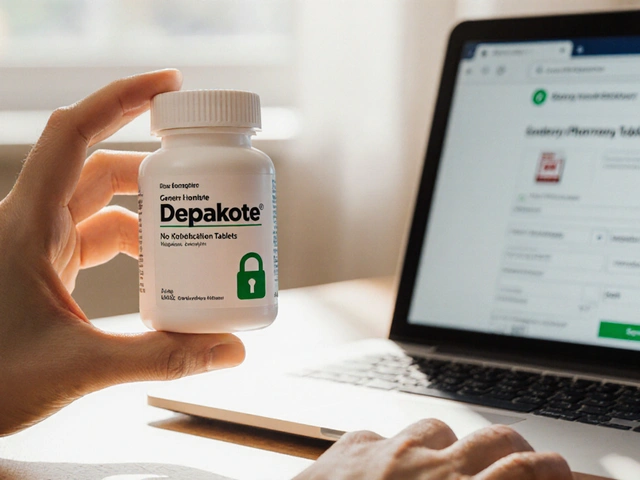Medication-Induced Angioedema Risk Checker
Common Medication Classes Linked to Angioedema
ACE Inhibitors
Lisinopril, Enalapril
Bradykinin AccumulationNSAIDs
Ibuprofen, Naproxen
Mast-cell ActivationDPP-4 Inhibitors
Sitagliptin, Saxagliptin
Reduced Bradykinin DegradationARBs
Losartan, Valsartan
Partial Bradykinin EffectH2 Blockers
Ranitidine, Famotidine
Histamine-MediatedOmalizumab
Xolair
IgE-Modulation ParadoxImagine waking up with swollen lips, a tight throat, and a sudden panic that the swelling might block your airway. For many, that nightmare is caused not by food or an allergy, but by a medication they never suspected could provoke such a reaction. This article unpacks how common drugs set off angioedema, what mechanisms are at play, and how patients and clinicians can stay a step ahead.
What Is Angioedema?
Angioedema is a sudden swelling of the deeper layers of the skin and mucous membranes, often affecting the face, lips, tongue, and airway. Unlike a typical rash, the swelling appears without the red, itchy surface lesions that characterize hives. When it involves the throat or airway, it becomes a medical emergency. The condition can be hereditary, idiopathic, or triggered by external factors-most notably, medications.
Why Medications Are a Major Trigger
Drug‑induced angioedema accounts for up to 30% of adult cases seen in emergency departments. The culprit isn’t always an allergic IgE response; many drugs act through other pathways, such as excess bradykinin or complement activation, that bypass classic allergy testing.
High‑Risk Drug Classes
Below is a snapshot of the drug families most frequently linked to angioedema. Each entry includes the primary mechanism and typical clinical clues.
| Drug Class | Key Examples | Mechanism | Onset |
|---|---|---|---|
| ACE Inhibitors | Lisinopril, Enalapril | Bradykinin accumulation | Hours to months |
| NSAIDs | Ibuprofen, Naproxen | Prostaglandin shift, mast‑cell activation | Minutes to days |
| DPP‑4 Inhibitors | Sitagliptin, Saxagliptin | Reduced degradation of bradykinin | Days to weeks |
| ARBs | Losartan, Valsartan | Partial bradykinin effect | Weeks to months |
| H2 Blockers | Ranitidine, Famotidine | Histamine‑mediated | Hours |
| Omalizumab | Xolair | IgE‑modulation paradox | Weeks |
How Each Class Sets Off the Swelling
ACE inhibitors block the conversion of angiotensin I to angiotensin II and simultaneously inhibit the breakdown of bradykinin. The excess bradykinin dilates blood vessels and makes them leaky, leading to fluid buildup in the deeper skin layers.
NSAIDs inhibit cyclooxygenase enzymes, shifting arachidonic acid metabolism toward leukotriene production. That shift can trigger mast‑cell degranulation, releasing histamine and other mediators that cause swelling.
DPP‑4 inhibitors reduce the breakdown of both incretin hormones and bradykinin. The resulting bradykinin buildup mirrors the ACE‑inhibitor effect, though it often appears later in therapy.
ARBs (angiotensinII receptor blockers) were once thought to be safe, but they can still allow modest bradykinin accumulation, especially when combined with ACE inhibitors.
H2 blockers and Omalizumab are rarer triggers. H2 blockers may interfere with histamine regulation, while Omalizumab’s IgE‑targeting action can paradoxically unmask underlying angioedema in susceptible patients.

Spotting Drug‑Induced Angioedema
- Timing: Swelling appears after starting a new medication or increasing the dose.
- No obvious allergen exposure (foods, insect stings).
- Absence of urticaria-most drug‑induced cases lack the classic hives.
- Recurrence after re‑exposure to the same drug class.
When in doubt, a thorough medication history is the single most valuable tool. Ask patients about over‑the‑counter analgesics, supplements, and any recent changes in chronic therapies.
Management Strategies for Patients and Clinicians
- Immediate care: If airway involvement is suspected, call emergency services and administer intramuscular epinephrine, even if the reaction isn’t classic anaphylaxis.
- Discontinue the suspected drug: Stop the medication as soon as possible. In many cases, swelling begins to resolve within 24‑48hours once the trigger is gone.
- Pharmacologic therapy:
- H1 antihistamines (cetirizine, diphenhydramine) help when histamine plays a role.
- Corticosteroids (prednisone) are useful for reducing inflammation, though they act slower.
- Bradykinin‑targeted agents (icatibant) are approved for hereditary angioedema but have been used off‑label for ACE‑inhibitor‑related cases.
- Alternative medication selection: Choose drugs with a lower angioedema risk profile. For hypertension, calcium‑channel blockers or thiazide diuretics are common substitutes for ACE inhibitors.
- Patient education: Provide a clear list of “trigger meds” and advise them to wear a medical alert bracelet.
Quick Checklist for Clinicians
- Review current prescription and OTC list for high‑risk classes.
- Ask about recent dose changes or new drug starts.
- Document any prior angioedema episodes and their triggers.
- If suspecting drug‑induced angioedema, stop the drug and monitor for improvement.
- Consider referral to an allergist for definitive testing when the cause is unclear.
When to Seek Specialist Help
Recurrent episodes, especially when the offending drug cannot be replaced (e.g., a life‑saving ACE inhibitor for heart failure), merit an evaluation by an immunology or allergy specialist. They can perform complement C1‑esterase inhibitor testing, consider prophylactic therapy, and guide safe rechallenge protocols if needed.
Frequently Asked Questions
Can I get angioedema from over‑the‑counter pills?
Yes. Common OTC pain relievers like ibuprofen and naproxen belong to the NSAID class, which can trigger angioedema in susceptible individuals.
Why do ACE inhibitors cause swelling even months after I start them?
ACE inhibitors raise bradykinin levels, and the buildup can be gradual. Some patients develop swelling weeks or even years later, making it tricky to pinpoint the cause without a medication review.
Is it safe to switch from an ACE inhibitor to an ARB if I had angioedema?
Many clinicians try an ARB after an ACE‑inhibitor reaction because the risk is lower, but it’s not zero. Close monitoring during the first few weeks is essential.
Do antihistamines always work for drug‑induced angioedema?
Antihistamines help when histamine is a major player (e.g., NSAIDs), but they’re less effective for bradykinin‑mediated cases like those from ACE inhibitors. In those situations, other treatments or drug cessation are key.
Can I continue my diabetes medication if it’s a DPP‑4 inhibitor?
If you’ve experienced angioedema while on a DPP‑4 inhibitor, discuss alternatives (like GLP‑1 agonists) with your endocrinologist. Switching is usually safe and eliminates the risk.





One comment
Patients on ACE inhibitors should be aware that bradykinin buildup can manifest weeks after the first dose. A thorough med history helps catch those delayed reactions before they become emergencies. If you notice swelling of lips or tongue, stop the drug and seek care promptly. Education about alternative antihypertensives can reduce future risk. Open communication with your prescriber is key.
NSAIDs are often the silent culprits.
Even over‑the‑counter ibuprofen can tip the balance toward mast‑cell activation, especially in sensitive folks 😊. Remember to review all pain relievers, not just prescriptions. A quick check of the medication list can spare you a scary episode. Stay proactive and keep your healthcare team in the loop! 👍
Let us consider the mechanistic cascade when an ACE inhibitor blocks angiotensin‑converting enzyme; the resultant bradykinin excess is not merely a biochemical footnote, it is a potential harbinger of life‑threatening edema. The latency period, ranging from hours to months, adds a veil of unpredictability that challenges even seasoned clinicians. Moreover, the interplay with concomitant NSAID use may amplify vascular permeability. It is incumbent upon us to vigilantly monitor patients during the initiation and titration phases. Failure to do so can culminate in airway compromise, a scenario no practitioner wishes to encounter. Hence, a judicious selection of antihypertensive therapy remains paramount.
Your exposition captures the gravity of bradykinin‑mediated swelling, yet we must also acknowledge the patient’s lived experience-sudden lip puffiness can be terrifying. In practice, a simple question about recent NSAID consumption often uncovers a dual trigger. Clinicians should therefore adopt a dual‑assessment strategy: evaluate both ACE inhibitor exposure and any over‑the‑counter analgesic use. Education, in my view, is the most potent prophylactic tool.
Across cultures, the perception of medication risk varies, but the underlying physiology stays the same-excess kinins or histamine leak into tissues, and the body reacts. Some physicians lean on calcium‑channel blockers as safe alternatives, while others prefer thiazides; the choice often reflects regional prescribing habits. It’s fascinating how a single drug class can spark a global conversation about safety. 🤔 Remember, patient empowerment begins with clear, jargon‑free explanations. A well‑informed patient is less likely to deviate from therapy.
While your cultural observations are appreciated, the scientific discourse demands rigorous precision. First, the statement that “excess kinins or histamine leak into tissues” negligently conflates two distinct pathways; bradykinin and histamine are not interchangeable mediators. Second, the claim that “physiology stays the same” ignores polymorphic variations in enzyme activity among ethnic groups, a fact well documented in pharmacogenomics literature. Third, referring to calcium‑channel blockers as “safe alternatives” without qualifying the evidence is misleading; safety profiles differ among patients with comorbidities such as heart failure. Fourth, the phrase “regional prescribing habits” should be supported by epidemiological data rather than anecdotal observation. Fifth, asserting that “patient empowerment begins with clear, jargon‑free explanations” is commendable, yet you simultaneously employ jargon like “pharmacogenomics” without definition, undermining accessibility. Sixth, the use of the emoji 🤔, while informal, may dilute the seriousness of the message in a clinical context. Seventh, the final admonition that “a well‑informed patient is less likely to deviate from therapy” overlooks the complex psychosocial factors influencing adherence, including health literacy and socioeconomic status. Eighth, you omitted any reference to the role of regulatory guidelines when recommending drug substitutions. Ninth, the sentence structure throughout oscillates between passive and active voice, reducing readability. Tenth, the absence of citations makes the assertions appear speculative rather than evidence‑based. Eleventh, the paragraph lacks a concise summary that would aid retention of key points. Twelfth, the intermittent use of commas creates run‑on sentences that could be parsed more clearly. Thirteenth, the term “global conversation” is hyperbolic given the limited scope of your discussion. Fourteenth, the statement “the choice often reflects regional prescribing habits” should be qualified with examples from peer‑reviewed studies. Fifteenth, your concluding remark fails to address the initial premise about cultural differences in risk perception, leaving the argument incomplete. Finally, for the sake of academic integrity, future contributions should be meticulously edited to avoid such inaccuracies and to uphold the standards of medical literature.